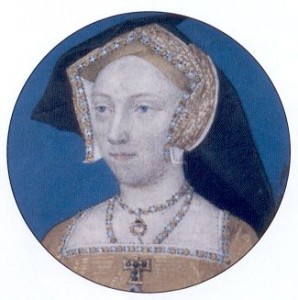
The ‘quickening’ of Henry and Jane’s baby was a joyous occasion and it sparked off celebrations across the country. In London, a Te Deum was sung in St Paul’s Cathedral, fires were lit and wine was enjoyed by the people. Here is an excerpt from Charles Wriothesley’s chronicle:
“Alsoe, the 27th daye of Maye 1537, being Trynytie Sondaye, there was Te Deum sounge in Powles for joye of the Queenes quickninge of childe, my Lord Chaunseler, Lord Privaye Seale, with diverse other Lordes and Bishopps, beinge then present; the Mayre and Aldermen with the beste craftes of the cyttye beinge there in their lyveryes, all gevinge laude and prayse to God for joye of the same, wher the Bishopp of Worcester, called Docter Latymer, made an oration afore all the Lordes and Commons, after Te Deum was songe, shewinge the cause of their assemblye, which oration was mervelouse fruitefull to the hearers; and alsoe the same night was diverse greate fyers made in London, and a hogeshead of wyne at everye fyer for poore people to drinke as longe as yt woulde laste; I praye Jesue, and it be his will, send us a Prince.”1
In Oxford, a sermon was preached:
“The last and greatest benefit, the special cause of their assembly, is “that our most excellent lady and mistress queen Jane, our noble and godly prince’s, King Henry the Eighth’s, wife, hath conceived and is great with child, and upon Trinity Sunday, like one given of God, the child quickened in the mother’s womb.” Exhorts them to give praise, and pray that it may be a prince.”2
And there were also celebrations in the English strongholds across the Channel. William, Lord Sandys, wrote to Lord Lisle, the Deputy of Calais, on 1st June 1537 regarding the news from England and the celebrations organised in Guines and Calais:
“I have this afternoon received from you the most joyful news ever sent me. No greater comfort ever came to my knowledge next to the prosperous estate of our Sovereign lord. You inform me that fires are to be made and Te Denm sung, and guns shot off at Calais at 4 o’clock. Too much honour cannot be done to the occasion, and I will do the same here, but this day is too far spent to do it publicly, and I have warned the curates of this county to meet at the parish church to-morrow morning and have a solemn mass with Te Denm after. There will also be a fire in the market-place and gun shot; so I trust the news will be known to all my neighbours, and your Lordship will perceive the doing thereof, if the wind suffer it to be heard.”3
And on 3rd June, Thomas Howard, 3rd Duke of Norfolk, wrote to Cromwell informing him of the preparations for celebrations in the city of York:
“Hopkins will report what he has done about the good news of the Queen’s being quick with child. This afternoon Te Deum shall be sung and this night bonfires made through all this city. Has ordered four hogsheads of wine out of his cellar to be laid abroad at night to be drunk in divers places freely.”4
Confirmation of Jane’s pregnancy was good news, it was something to be celebrated because England had renewed hope for an heir to the throne, a prince. However, as David Cressy points out in his book Birth, Marriage, and Death: Ritual, Religion, and the Life-Cycle in Tudor and Stuart England, quickening “also marked a new stage of anxiety” and points out that 16th century diarists “report quickening as the critical time of their wives’ pregnancies, when the risk of miscarriage was most acute”, so Henry and Jane’s joy must have been mixed with worry.5 Of course, we know that this pregnancy did result in the birth of a prince, the future Edward VI, on 12th October 1537.
Also on this day in history…
- 1536 – Cardinal Reginald Pole sent Henry VIII a copy of De Unitate (Pro Ecclesiasticae Unitatis Defensione). In it, he criticised the King’s divorce and the trouble it had caused.
- 1541 – Execution of Margaret Pole, suo jure (in her own right) Countess of Salisbury. It is recorded that she was beheaded by “a wretched and blundering youth… who literally hacked her head and shoulders to pieces in the most pitiful manner”. She was buried in the Chapel of St Peter ad Vincula. Click here to read more about her execution.
Notes and Sources
- Wriotheseley, Charles. A chronicle of England during the reigns of the Tudors, from A.D. 1485 to 1559, p64.
- Letters and Papers, Foreign and Domestic, Henry VIII, Volume XII, Part I, 1325.
- LP xii, ii. 11.
- LP xii, ii. 22.
- Cressy, David (1997) Birth, Marriage, and Death: Ritual, Religion, and the Life Cycle in Tudor and Stuart England, p45.